Assessment of Soil Suitability for Improvement of Soil Factors and Agricultural Management
Abstract
:1. Introduction
2. Material and Methods
2.1. Study Area
2.2. Soil and Climate Databases
2.3. Soil Suitability Evaluation
Almagra Model
2.4. Spatial Analysis
2.5. Statistical Analysis for Soil Factors
3. Results and Discussion
3.1. Spatial Analysis and Soil Physiochemical Properties
3.1.1. Physiographic Units
3.1.2. Soil Properties
3.2. Soil Factors under Current and Optimal Scenarios
3.2.1. Soil Salinity
3.2.2. Sodium Saturation
3.2.3. Drainage
3.3. Soil Suitability
3.3.1. General Evaluation of Current Situation (CS) and Optimal Scenario (OS)
3.3.2. Soil Suitability for Studied Crops
4. Conclusions
Supplementary Materials
Author Contributions
Funding
Conflicts of Interest
References
- Santana-Cordero, A.M.; Ariza, E.; Romagosa, F. Studying the historical evolution of ecosystem services to inform management policies for developed shorelines. Environ. Sci. Policy 2016, 64, 18–29. [Google Scholar] [CrossRef]
- Hanh, H.Q.; Azadi, H.; Dogot, T.; Ton, V.D.; Lebailly, P. Dynamics of Agrarian Systems and Land Use Change in North Vietnam. Land Degrad. Dev. 2017, 28, 799–810. [Google Scholar] [CrossRef]
- Tengberg, A.; Radstake, F.; Zhang, K.; Dunn, B. Scaling up of Sustainable Land Management in the Western People’s Republic of China: Evaluation of a 10-Year Partnership. Land Degrad. Dev. 2016, 27, 134–144. [Google Scholar] [CrossRef]
- Lal, R. Soils and sustainable agriculture: A review. Agron. Sustain. Dev. 2009, 28, 57–64. [Google Scholar] [CrossRef]
- Brevik, E.C. The potential impact of climate change on soil properties and processes and corresponding influence on food security. Agriculture 2013, 3, 398–417. [Google Scholar] [CrossRef]
- Brevik, E.; Calzolari, C.; Miller, B.; Pereira, P.; Kabala, C.; Baumgarten, A.; Jordán, A. Historical perspectives and future needs in soil mapping, classification and pedological modelling. Geoderma 2016, 264, 256–274. [Google Scholar] [CrossRef]
- Panagos, P.; Borrelli, P.; Poesen, J.; Ballabio, C.; Lugato, E.; Meusburger, K.; Montanarella, L.; Alewell, C. The new assessment of soil loss by water erosion in Europe. Environ. Sci. Policy 2015, 54, 438–447. [Google Scholar] [CrossRef] [Green Version]
- Singh, A. Soil salinization and waterlogging: A threat to environment and agricultural sustainability. Ecol. Indic. 2016, 57, 128–130. [Google Scholar] [CrossRef]
- Velmurugan, A.; Swarnam, T.P.; Ambast, S.K.; Kumar, N. Managing waterlogging and soil salinity with a permanent raised bed and furrow system in coastal lowlands of humid tropics. Agric. Water Manag. 2016, 168, 56–67. [Google Scholar] [CrossRef]
- Sam, K.; Coulon, F.; Prpich, G. Working towards an integrated land contamination management framework for Nigeria. Sci. Total Environ. 2016, 571, 916–925. [Google Scholar] [CrossRef] [PubMed]
- Chartzoulakis, K.; Bertaki, M. Sustainable Water Management in Agriculture under Climate Change. Agric. Agric. Sci. Procedia 2015, 4, 88–98. [Google Scholar] [CrossRef] [Green Version]
- Longjun, C. UN Convention to Combat Desertification. In Encyclopedia of Environmental Health; Nriagu, J.O., Ed.; Elsevier: Burlington, NJ, USA, 2011; pp. 504–517. ISBN 9780444522726. [Google Scholar]
- Zhou, D.; Wang, X.; Shi, M. Human driving forces of oasis expansion in Northwestern china during the last decade—A case of study of the Heihe river basin. Land Degrad. Dev. 2017, 28, 412–420. [Google Scholar] [CrossRef]
- Ali, M. Management of salt-affected soils. In Practices of Irrigation & On-Farm Water Management; Springer: New York, NY, USA, 2011; Volume 2, pp. 271–325. [Google Scholar]
- Daliakopoulos, I.N.; Tsanis, I.K.; Koutroulis, A.; Kourgialas, N.N.; Varouchakis, A.E.; Karatzas, G.P.; Ritsema, C.J. The threat of soil salinity: A European scale review. Sci. Total Environ. 2016, 573, 727–739. [Google Scholar] [CrossRef] [PubMed]
- FAO (Food and Agriculture Organization). Salt-Affected Soils and Their Management; Soils Bulletin 39; FAO: Rome, Italy, 1988. [Google Scholar]
- Chi, C.M.; Zhao, C.W.; Sun, X.J.; Wang, Z.C. Reclamation of saline-sodic soil properties and improvement of rice (Oriza sativa L.) growth and yield using desulfurized gypsum in the west of Songnen Plain, northeast China. Geoderma 2012, 187, 24–30. [Google Scholar] [CrossRef]
- CAPMAS. Egypt Statistical Yearbook Population. 2015. Available online: http://www.capmas.gov.eg/Pages/Publications.aspx?page_id=5104&YearID=23011 (accessed on 12 July 2017).
- Gouda, A.A.; Hosseini, M.; Masoumi, H.E. The Status of Urban and Suburban Sprawl in Egypt and Iran. GeoScape 2016, 10, 1–15. [Google Scholar] [CrossRef] [Green Version]
- Negm, A.M.; Saavedra, O.; El-Adawy, A. Nile Delta Biography: Challenges and Opportunities. In The Nile Delta, The Handbook of Environmental Chemistry; Negm, A.M., Ed.; Springer: Cham, Switzerland, 2016; pp. 1–16. [Google Scholar]
- Mahmoud, H.; Divigalpitiya, P. Modeling Future Land Use and Land-Cover Change in the Asyut Region Using Markov Chains and Cellular Automata. In Smart and Sustainable Planning for Cities and Region; Springer: Cham, Switzerland, 2017; pp. 99–112. [Google Scholar]
- FAO (Food and Agriculture Organization). Land Evaluation: Towards a Revised Framework; Land and Water Discussion Paper 6; FAO: Rome, Italy, 2007; p. 107. [Google Scholar]
- Anaya-Romero, M.; Abd-Elmabod, S.K.; Muñoz-Rojas, M.; Castellano, G.; Ceacero, C.J.; Alvarez, S.; Méndez, M.; De la Rosa, D. Evaluating soil threats under climate change scenarios in the Andalusia region. Southern Spain. Land Degrad. Dev. 2015, 26, 441–449. [Google Scholar] [CrossRef]
- Rossiter, D.G. A Theoretical Framework for Land Evaluation. Geoderma 1996, 72, 165–202. [Google Scholar] [CrossRef]
- FAO (Food and Agriculture Organization). Guidelines: Land Evaluation for Irrigated Agriculture; Soils Bulletin 55; FAO: Rome, Italy, 1985. [Google Scholar]
- FAO (Food and Agriculture Organization). Guidelines for Land-Use Planning; FAO Development Series 1; FAO: Rome, Italy, 1993; p. 96. [Google Scholar]
- Sys, C.; Van Ranst, E.; Debaveye, J. Land Evaluation. Part 3: Crop Requirements; Agricultural Publications, General Administration of Development Cooperation: Belgium, Brussels, 1993; p. 199. [Google Scholar]
- Rossiter, D.G. ALES (Automated Land Evaluation System): A framework for land evaluation using a microcomputer. Soil Use Manag. 1990, 6, 7–20. [Google Scholar] [CrossRef]
- De la Rosa, D.; Moreno, J.A.; Garcia, L.V.; Almorza, J. MicroLEIS: A microcomputer-based Mediterranean land evaluation information system. Soil Use Manag. 1992, 8, 89–96. [Google Scholar] [CrossRef] [Green Version]
- De la Rosa, D.; Mayol, F.; Diaz-Pereira, E.; Fernandez, M. Aland evaluation decision support system (MicroLEIS DSS) for agricultural soil protection. Environ. Model. Softw. 2004, 19, 929–942. [Google Scholar] [CrossRef]
- Wenkel, K.O.; Berg, M.; Mirschel, W.; Wieland, R.; Nendel, C.; Köstner, B. LandCaRe DSS—An interactive decision support system for climate change impact assessment and the analysis of potential agricultural land use adaptation strategies. J. Environ. Manag. 2013, 127, S168–S183. [Google Scholar] [CrossRef] [PubMed]
- Pereira, P.; Brevik, E.; Munoz-Rojas, M.; Miller, B.; Smetanova, A.; Depellegrin, D.; Misiune, I.; Novara, A.; Cerda, A. Soil mapping and process modelling for sustainable land management. In Soil Mapping and Process Modelling for Sustainable Land Use Management; Pereira, P., Brevik, E., Munoz-Rojas, M., Miller, B., Eds.; Elsevier: Amsterdam, The Netherland, 2017; pp. 29–60. ISBN 9780128052006. [Google Scholar]
- Pereira, P.; Brevik, E.; Trevisani, S. Mapping the Environment. Sci. Total Environ. 2018, 610, 17–23. [Google Scholar] [CrossRef] [PubMed]
- Muñoz-Rojas, M.; Doro, L.; Ledda, L.; Francaviglia, R. Application of CarboSOIL model to predict the effects of climate change on soil organic carbon stocks in agro-silvo-pastoral Mediterranean management. Agric. Ecosyst. Environ. 2015, 202, 8–16. [Google Scholar] [CrossRef]
- Muñoz-Rojas, M.; Jordán, A.; Zavala, L.M.; De la Rosa, D.; Abd-Elmabod, S.K.; Anaya-Romero, M. Impact of land use and land cover changes on organic carbon stocks in Mediterranean soils (1956–2007). Land Degrad. Dev. 2015, 26, 168–179. [Google Scholar]
- Muñoz-Rojas, M.; Abd-Elmabod, S.K.; Zavala, L.M.; De la Rosa, D.; Jordán, A. Climate change impacts on soil organic carbon stocks of Mediterranean agricultural areas: A case study in Northern Egypt. Agric. Ecosyst. Environ. 2017, 238, 142–152. [Google Scholar] [CrossRef]
- De la Rosa, D. Soil Survey and Evaluation of Guadalquivir River Terraces, in Sevilla Province; Cent. Edaf. Cuarto Pub.: Seville, Spain, 1974. [Google Scholar]
- Farroni, A.; Magaldi, D.; Tallini, M. Total sediment transport by the rivers of Abruzzi (Central Italy): Prediction with the RAIZAL model. Bull. Eng. Geol. Environ. 2002, 61, 121–127. [Google Scholar]
- Erdogan, H.E.; Yüksel, M.; De La Rosa, D. Evaluation of Sustainable Land Management Using Agro-Ecological Evaluation Approach in Ceylanpınar State Farm (Turkey). Turk. J. Agric. For. 2003, 27, 15–22. [Google Scholar]
- López García, J.; Acosta, R.; Bojórquez Serrano, J.I. Aptitud relativa agrícola del municipio de Tuxpan, Nayarit, utilizando el modelo Almagra del Sistema MicroLEIS. Investig. Geogr. 2006, 59, 59–73. [Google Scholar] [CrossRef]
- Darwish, K.M.; Wahba, M.M.; Awad, F. Agricultural Soil Suitability of Haplo-Soils for Some Crops in Newly Reclaimed Areas of Egypt. Appl. Sci. Res. 2006, 12, 1235–1243. [Google Scholar]
- Bakr, N.; Bahnassy, M.H.; El-Badawi, M.M.; Ageeb, G.W.; Weindorf, D.C. Land capability evaluation in newly reclaimed areas: A case study in Bustan 3 area, Egypt. Soil Sur. Horiz. 2009, 51, 90–95. [Google Scholar] [CrossRef]
- Shahbazi, F.; De la Rosa, D.; Anaya-Romero, M.; Jafarzade, A.; Sarmadian, F.; Neyshaboury, M.; Oustam, S. Land use planning in Ahar area (Iran) using MicroLEIS DSS. Int. Agrophys. 2010, 22, 277–286. [Google Scholar]
- Muñoz-Rojas, M.; Jordán, A.; Zavala, L.M.; González-Peñaloza, F.A.; De la Rosa, D.; Pino-Mejias, R.; Anaya-Romero, M. Modelling soil organic C stocks in climate change scenarios: A CarboSOIL model application. Biogeosciences 2013, 10, 8253–8268. [Google Scholar]
- Abd-Elmabod, S.K.; Jordán, A.; Fleskens, L.; Phillips, J.D.; Muñoz-Rojas, M.; Van der Ploeg, M.; Anaya-Romero, M.; De la Rosa, D. Modelling agricultural suitability along soil transects under current conditions and improved scenario of soil factors. In Soil Mapping and Process Modeling for Sustainable Land Use Management; Elsevier: Amsterdam, The Netherland, 2017; pp. 193–219. ISBN 9780128052006. [Google Scholar]
- ASRT (Academy of Scientific Research and Technology). Preparation of Land Data Base for Agriculture Use” Fifth Report; ASRT: Cairo, Egypt, 2009. [Google Scholar]
- Soil Survey Staff. Keys to Soil Taxonomy, 12th ed.; United States Department of Agriculture, Natural Resources Conservation Service: Washington, DC, USA, 2014.
- Haroun, O.R. Soil Evaluation Systems as a Guide to Identify an Economical Feasibility Study for Agricultural Purposes in El-Fayoum Province, Egypt. Ph.D. Thesis, Faculty of Agriculture, El-Fayoum Cairo University, El-Fayoum, Egypt, 2004. [Google Scholar]
- Ali, R.R. Geomatics Based Soil Mapping and degradation risk Assessment of the Cultivated Land in El-Fayoum Depression Egypt. J. Soil Sci. 2005, 45, 349–360. [Google Scholar]
- CLAC (Central Laboratory for Agricultural Climate). The Climatic Normals-El Fayoum Station; Annual Report; Central Laboratory for Agricultural Climate CLAC: Cairo, Egypt, 2010. [Google Scholar]
- De la Rosa, D.; Cardona, F.; Paneque, G. Evaluación de suelos para diferentes usos agrícolas. Un sistema desarrollado para regiones mediterráneas. Anales de Edafología y Agrobiología 1977, 36, 1100–1112. [Google Scholar]
- Manna, P.; Basile, A.; Bonfante, A.; De Mascellis, R.; Terribile, F. Comparative Land Evaluation approaches: An itinerary from FAO framework to simulation modelling. Geoderma 2009, 150, 367–378. [Google Scholar] [CrossRef]
- De la Rosa, D.; Anaya-Romero, M.; Diaz-Pereira, E.; Heredia, N.; Shahbazi, F. Soil-Specific Agro-Ecological Strategies for Sustainable Land Use-A Case Study by Using MicrolEIS DSS in Sevilla Province (Spain). Land Use Policy 2009, 26, 1055–1065. [Google Scholar] [CrossRef]
- Aldabaa, A.A.; HaiLin, Z.; Shata, A.; El-Sawey, S.; Abdel-Hameed, A.; Schroder, J.L. Land suitability classification of a desert area in Egypt for some crops using MicrolEIS program. Am.-Eurasian J. Agric. Environ. Sci. 2010, 8, 80–94. [Google Scholar]
- Darwish, K.M.; Kawy, W.A. Land suitability decision support for assessing land use changes in areas west of Nile Delta, Egypt. Arab. J. Geosci. 2014, 7, 865–875. [Google Scholar] [CrossRef]
- ESRI (Environmental Systems Research Institute). ArcGIS Desktop: Release 10.4; Environmental Systems Research Institute: Redlands, CA, USA, 2016. [Google Scholar]
- Shendi, M.M. Pedological Studies on Soils Adjacent to Qarun Lake, Fayoum Governorate, Egypt. Master’s Thesis, Faculty of Agriculture, Cairo University, Giza, Egypt, 1984. [Google Scholar]
- Soil Survey Division Staff. Soil survey manual. In U.S. Department of Agriculture Handbook 18; Soil Conservation Service: Washington, DC, USA, 1993. [Google Scholar]
- IUSS (International Union of Soil Sciences); ISRIC (ISRIC World Soil Information); FAO (Food and Agriculture Organization). World Reference Base for Soil Resources and Communication; World Soil Resources Report 103; International Union of Soil Sciences, ISRIC World Soil Information, FAO: Rome, Italy, 2006. [Google Scholar]
- IBM SPSS. IBM SPSS Statistics for Windows, Version.23.0; IBM Corp.: Armonk, NY, USA, 2015. [Google Scholar]
- Zalacáin, D.; Martínez-Pérez, S.; Bienes, R.; García-Díaz, A.; Sastre-Merlín, A. Salt accumulation in soils and plants under reclaimed water irrigation in urban parks of Madrid (Spain). Agric. Water Manag. 2019, 213, 468–476. [Google Scholar] [CrossRef]
- Qadir, M.; Schubert, S. Degradation processes and nutrient constraints in sodic soils. Land Degrad. Dev. 2002, 13, 275–294. [Google Scholar] [CrossRef]
- Jacobsen, S.E.; Jensen, C.R.; Liu, F. Improving crop production in the arid Mediterranean climate. Field Crops Res. 2012, 128, 34–47. [Google Scholar] [CrossRef]
- Balks, M.R.; Bond, W.J.; Smith, C.J. Effects of sodium accumulation on soil physical properties under an effluent-irrigated plantation. Soil Res. 1998, 36, 821–830. [Google Scholar] [CrossRef]
- Paes, J.L.; Ruiz, H.A.; Fernandes, R.B.; Freire, M.B.; Barros, M.D.; Rocha, G.C. Hydraulic conductivity in response to exchangeable sodium percentage and solution salt concentration. Revista Ceres 2014, 61, 715–722. [Google Scholar] [CrossRef] [Green Version]
- Rasouli, F.; Pouya, A.K.; Karimian, N. Wheat yield and physico-chemical properties of a sodic soil from semi-arid area of Iran as affected by applied gypsum. Geoderma 2013, 193, 246–255. [Google Scholar] [CrossRef]
- Temiz, C.; Cayci, G. The effects of gypsum and mulch applications on reclamation parameters and physical properties of an alkali soil. Environ. Monit. Assess. 2018, 190, 347. [Google Scholar] [CrossRef] [PubMed]
- Anikwe, M.A.N.; Ibudialo, E.A.N. Influence of lime and gypsum application on soil properties and yield of cassava (Manihot esculenta Crantz.) in a degraded Ultisol in Agbani, Enugu Southeastern Nigeria. Soil Till. Res. 2016, 158, 32–38. [Google Scholar] [CrossRef]
- Abrol, I.P.; Jai Singh, P.Y.; Massoud, F.I. Salt-Affected Soils and Their Management; No. 39; Food & Agriculture Org.: Rome, Italy, 1988. [Google Scholar]
- Chang, X.; Gao, Z.; Wang, S.; Chen, H. Modelling long-term soil salinity dynamics using SaltMod in Hetao Irrigation District, China. Comput. Electron. Agric. 2019, 156, 447–458. [Google Scholar] [CrossRef]
- Hu, Z.Y.; Zaho, F.J.; McGrath, S.P. Sulphur fractionation in calcareous soils and bioavailability to plants. Plant Soil 2005, 268, 103–109. [Google Scholar] [CrossRef]
- Yazdanpanah, N.; Mahmoodabadi, M.; Cerdà, A. The impact of organic amendments on soil hydrology, structure and microbial respiration in semiarid lands. Geoderma 2016, 266, 58–65. [Google Scholar] [CrossRef]
- Assefa, T.; Jha, M.; Reyes, M.; Worqlul, A.W. Modeling the Impacts of Conservation Agriculture with a Drip Irrigation System on the Hydrology and Water Management in Sub-Saharan Africa. Sustainability 2018, 10, 19. [Google Scholar] [CrossRef]
- Park, T.W.; Kim, H.J.; Tanvir, M.T.; Lee, J.B.; Moon, S.G. Influence of coarse particles on the physical properties and quick undrained shear strength of fine-grained soils. Geomech. Eng. 2018, 14, 99–105. [Google Scholar]
- Feng, W.Q.; Li, C.; Yin, J.H.; Chen, J.; Liu, K. Physical model study on the clay–sand interface without and with geotextile separator. Acta Geotech. 2019, 1–17. [Google Scholar] [CrossRef]
- Valipour, M. Drainage, waterlogging, and salinity. Arch. Agron. Soil Sci. 2014, 60, 1625–1640. [Google Scholar] [CrossRef]
- Ali, R.R.; Abdel Kawy, W.A. Land degradation risk assessment of El Fayoum depression, Egypt. Arab J. Geosci. 2013, 6, 2767–2776. [Google Scholar] [CrossRef]
- Abd-Elmabod, S.K. Evaluation of Soil Degradation and Land Capability in Mediterranean Areas under Climate and Management Change Scenarios: (Andalusia Region, Spain and El-Fayoum Province, Egypt). Ph.D. Thesis, Universidad de Sevilla, Sevilla, Spain, 2014. [Google Scholar]
- Amin, A.A.; Gergis, M.F. Integrated management strategies for control of cotton key pests in middle Egypt. Agron. Res. 2006, 4, 121–128. [Google Scholar]
- Manrique, L.A.; Uehara, G. A Proposed Land Suitability Classification for Potato: I. Methodology 1. Soil Sci. Soc. Am. J. 1984, 48, 843–847. [Google Scholar] [CrossRef]
- Abagyeh, S.O.; Idoga, S.; Agber, P.I. Land suitability evaluation for maize (Zea mays) production in selected sites of the Mid-Benue valley, Nigeria. IJAPR 2016, 4, 46–51. [Google Scholar]
- Akinrinde, E.A.; Bello, O.S.; Ayegboyin, K.O.; Iroh, L. Added benefits of combined organic and mineral phosphate fertilizers applied to maize and melon. J. Food Agric. Environ. 2005, 3, 75. [Google Scholar]
- Kavvadias, V.; Papadopoulou, M.; Vavoulidou, E.; Theocharopoulos, S.; Repas, S.; Koubouris, G.; Psarras, G.; Kokkinos, G. Effect of addition of organic materials and irrigation practices on soil quality in olive groves. J. Water Clim. Chang. 2018, 9, 775–785. [Google Scholar] [CrossRef]
- Jafarzadeh, A.A.; Abbasi, G. Qualitative land suitability evaluation for the growth of onion, potato, maize, and alfalfa on soils of the Khalat pushan research station. Biologia 2006, 61, S349–S352. [Google Scholar] [CrossRef]
- Ashraf, S.; Afshari, H.; Munokyan, R.; Ebadi, A.G. Multicriteria land suitability evaluation for barley by using GIS in Damghan plain (Northeast of Iran). J. Food Agric. Environ. 2010, 8, 626–628. [Google Scholar]
- El-Aziz, S.H. Evaluation of land suitability for main irrigated crops in the North-Western Region of Libya. Eurasian J. Soil Sci. 2018, 7, 73–86. [Google Scholar] [CrossRef]
- Doolittle, J.; Dobos, R.; Peaslee, S.; Waltman, S.; Benham, E.; Tuttle, W. Revised Ground-Penetrating Radar Soil Suitability Maps. J. Environ. Eng. Geophys. 2010, 15, 111–118. [Google Scholar] [CrossRef]
- Ennaji, W.; Barakat, A.; El Baghdadi, M.; Oumenskou, H.; Aadraoui, M.; Karroum, L.A.; Hilali, A. GIS-based multi-criteria land suitability analysis for sustainable agriculture in the northeast area of Tadla plain (Morocco). J. Earth Syst. Sci. 2018, 127, 14. [Google Scholar] [CrossRef]
- Salkovic, E.; Djurovic, I.; Knezevic, M.; Popovic-Bugarin, V.; Topalovic, A. Digitization and Mapping of National Legacy Soil Data of Montenegro. Soil Water Res. 2018, 13, 83–89. [Google Scholar] [CrossRef]
- Liu, Y.-S.; Wang, J.-Y.; Guo, L.-Y. GIS-based assessment of land suitability for optimal allocation in the Qinling Mountains, China. Pedosphere 2006, 16, 579–586. [Google Scholar] [CrossRef]
- Safari, Y.; Esfandiarpour-Boroujeni, I.; Kamali, A.; Salehi, M.H.; Bagheri-Bodaghabadi, M. Qualitative land suitability evaluation for main irrigated crops in the shahrekord plain, Iran: A geostatistical approach compared with conventional method. Pedosphere 2013, 23, 767–778. [Google Scholar] [CrossRef]
- Lara-Estrada, L.D.; Rasche, L.; Schneider, U. Modeling land suitability for Coffea arabica L. in Central America. Environ. Model. Softw. 2017, 95, 96–209. [Google Scholar] [CrossRef]
- Zabihi, H.; Ahmad, A.; Vogeler, I.; Said, M.N.; Golmohammadi, M.; Golein, B.; Nilashi, M. Land suitability procedure for sustainable citrus planning using the application of the analytical network process approach and GIS. Comput. Electron. Agric. 2015, 117, 114–126. [Google Scholar] [CrossRef]
- Zhang, J.; Su, Y.; Wu, J.; Liang, H. GIS based land suitability assessment for tobacco production using AHP and fuzzy set in Shandong province of China. Comput. Electron. Agric. 2015, 114, 202–211. [Google Scholar] [CrossRef]
- Bo, L.; Zhang, F.; Zhang, L.W.; Huang, J.F.; Zhi-Feng, J.I.; Gupta, D.K. Comprehensive suitability evaluation of tea crops using GIS and a modified land ecological suitability evaluation model. Pedosphere 2012, 22, 122–130. [Google Scholar]
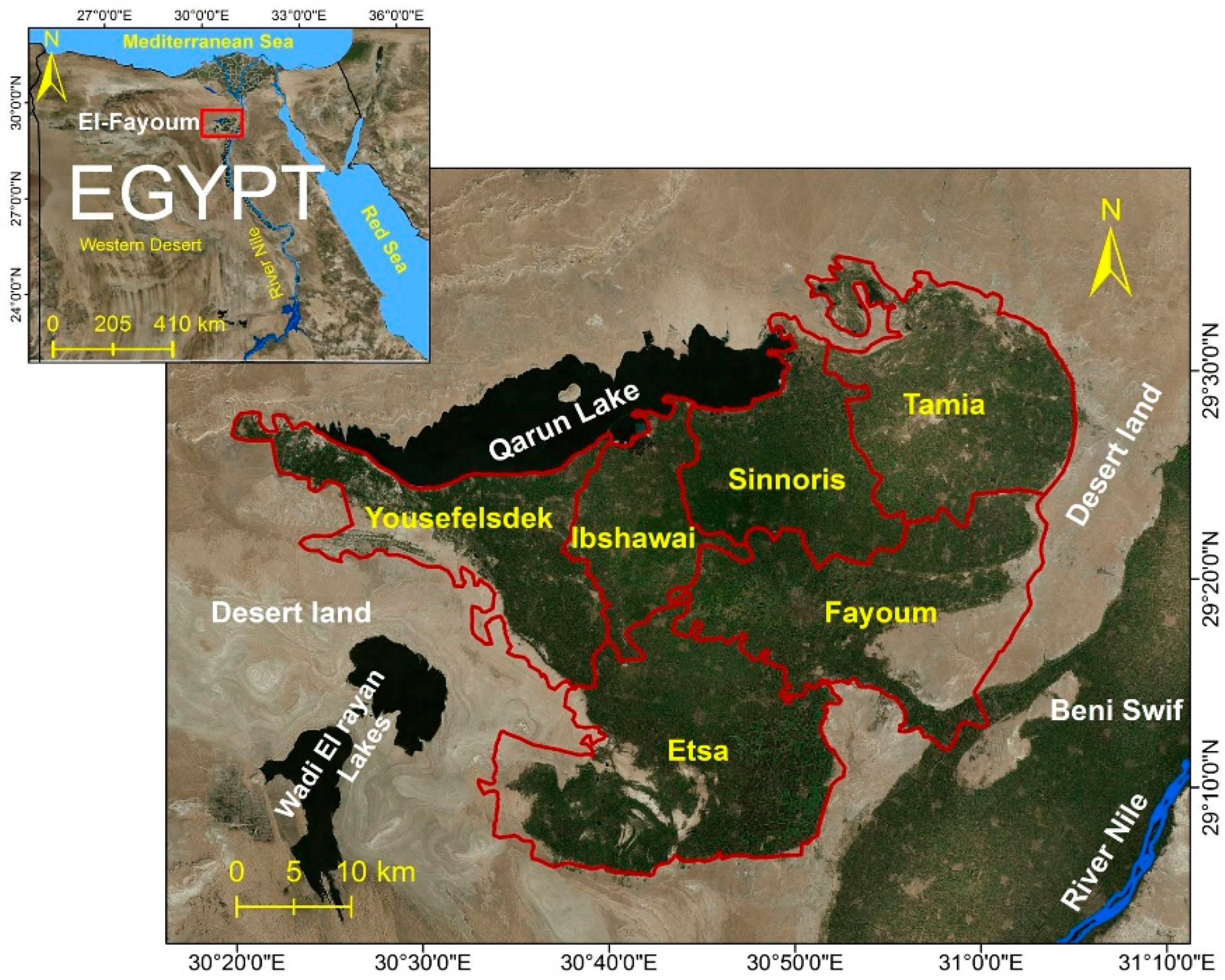
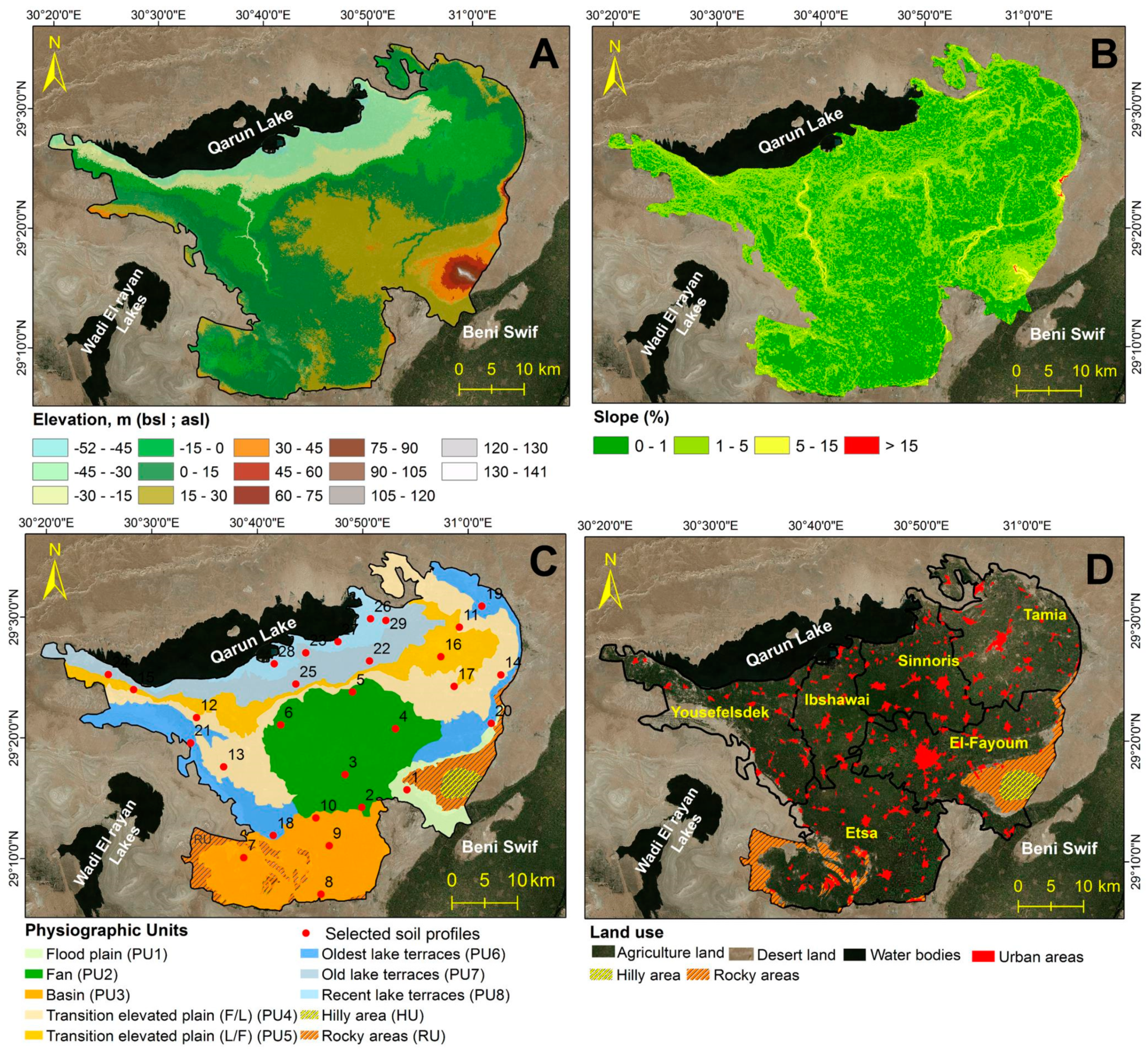
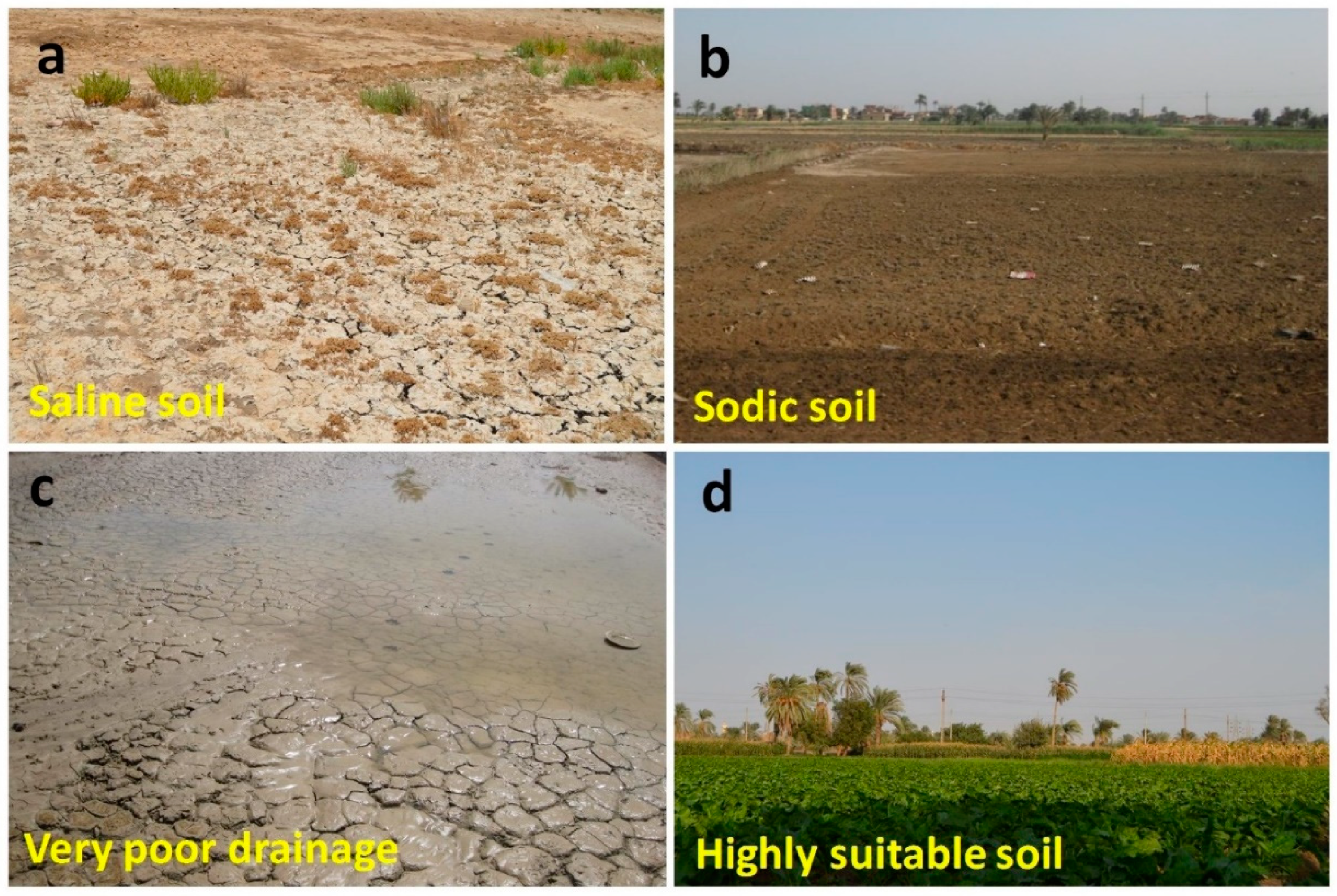

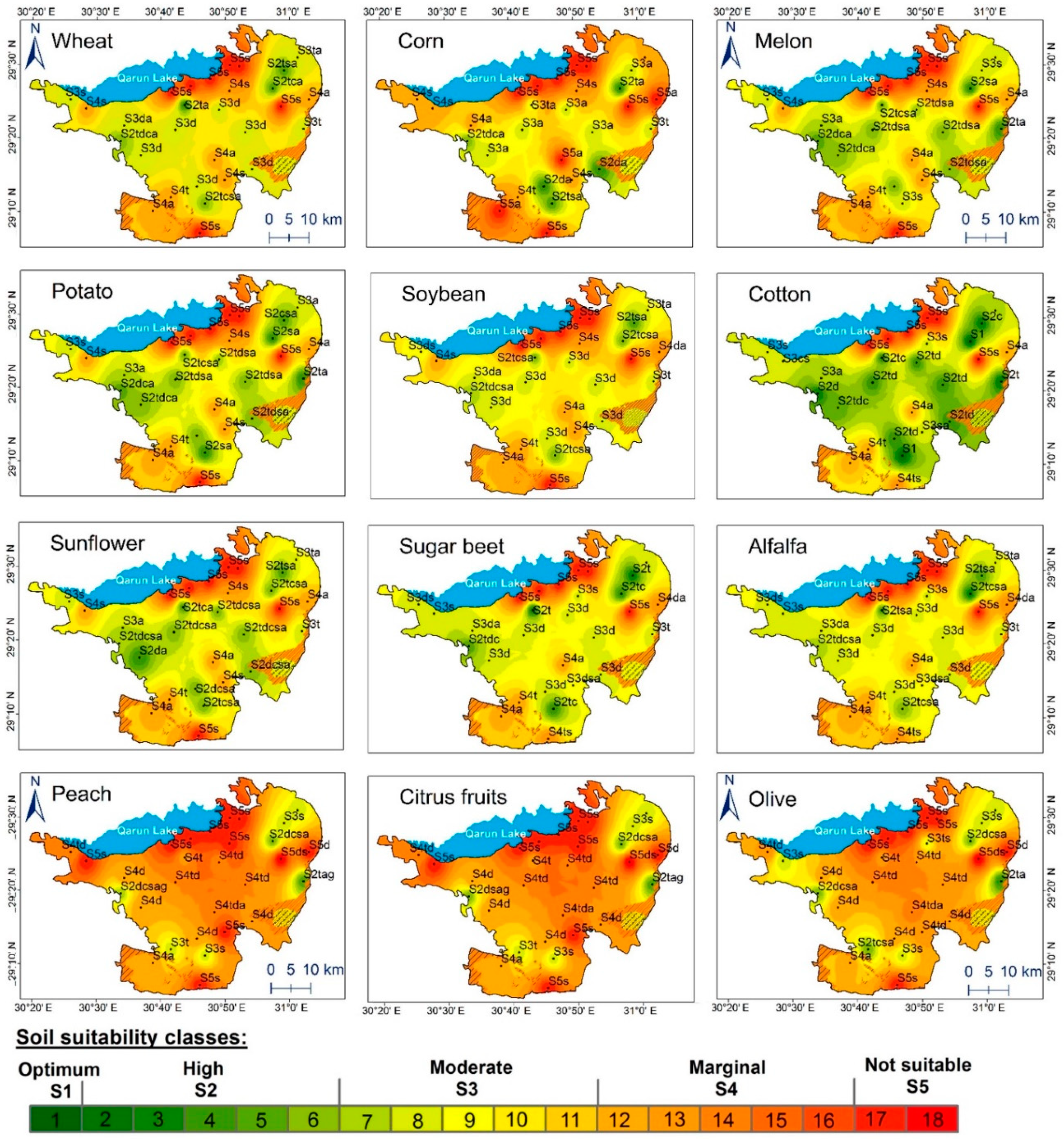
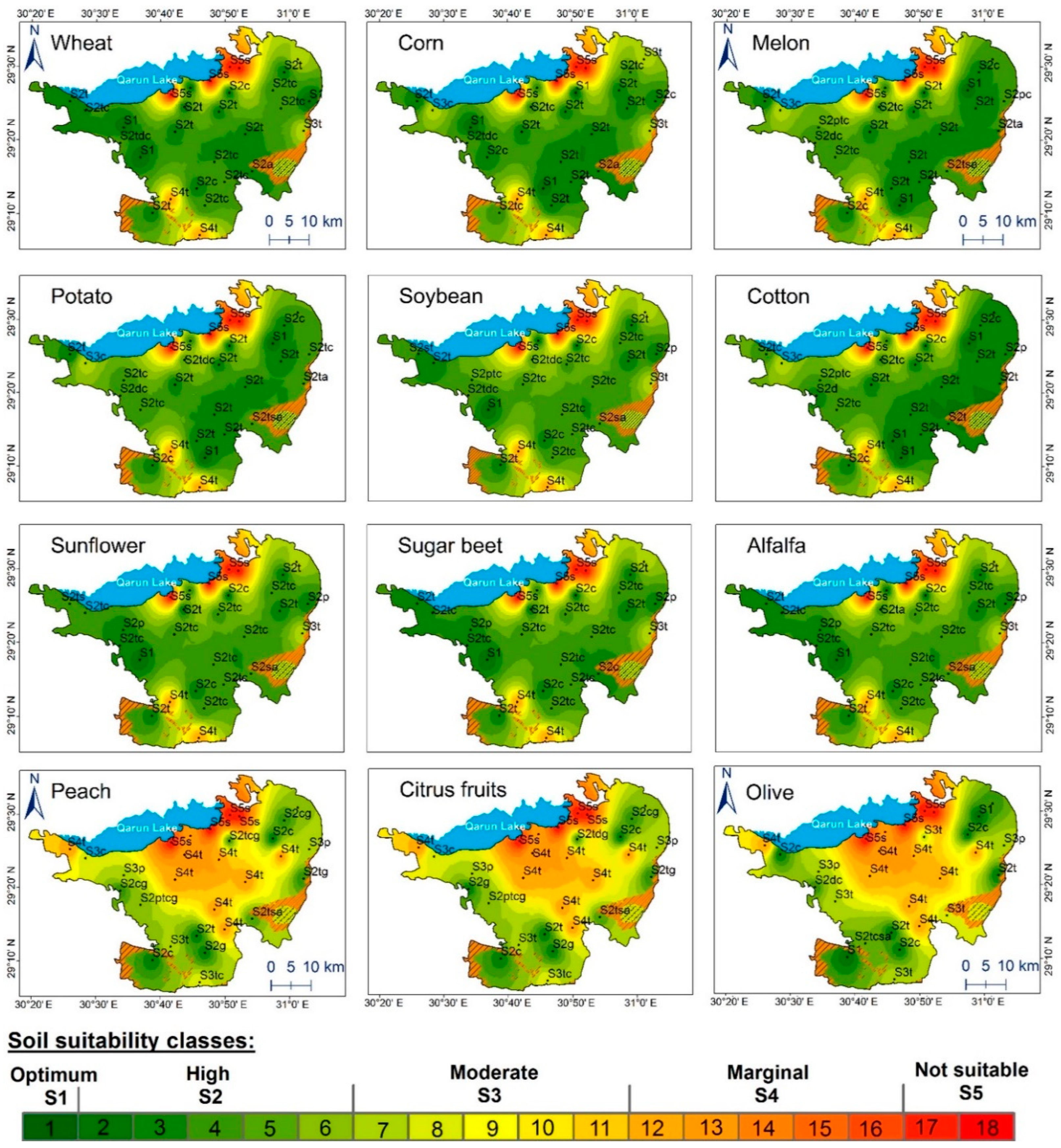
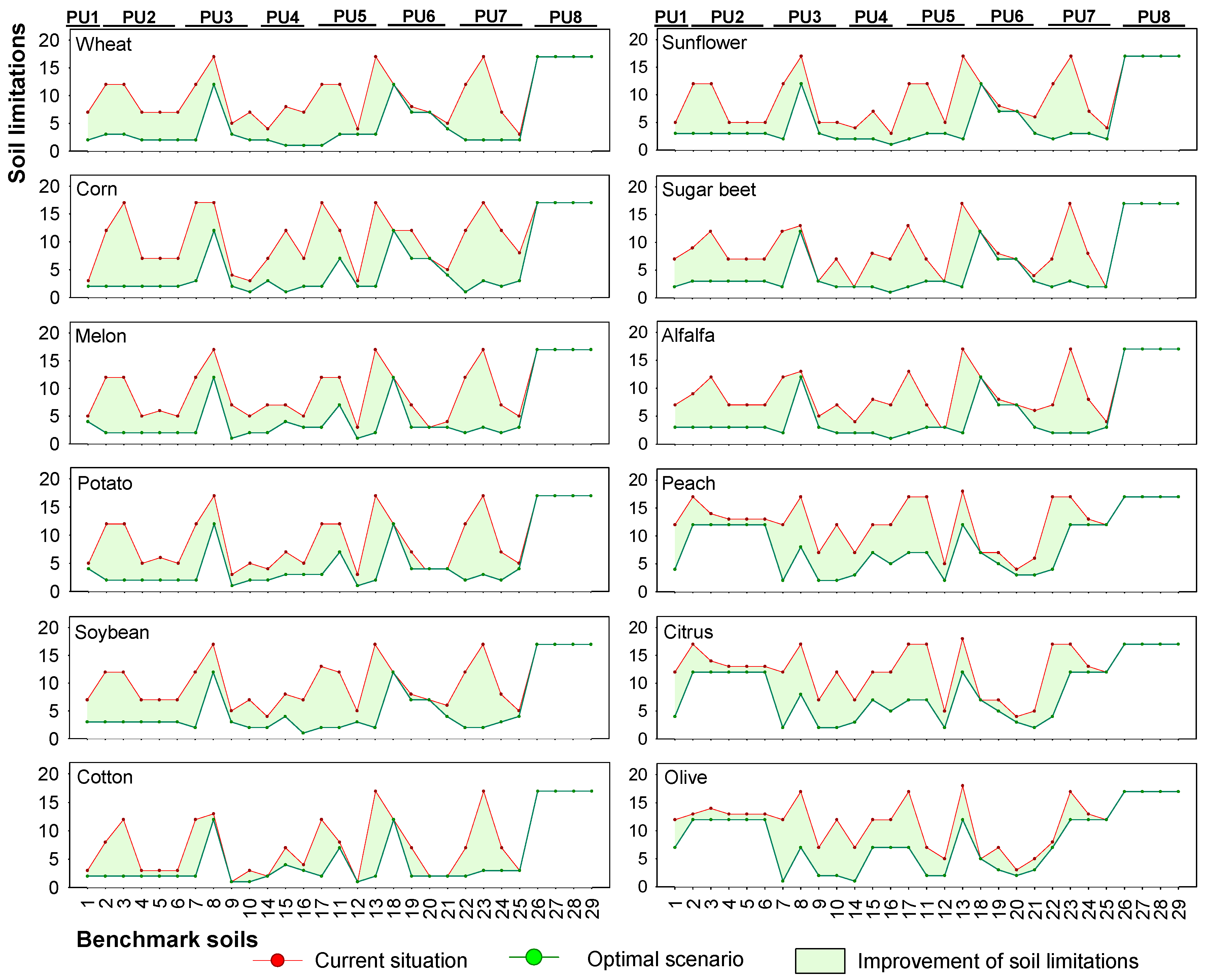
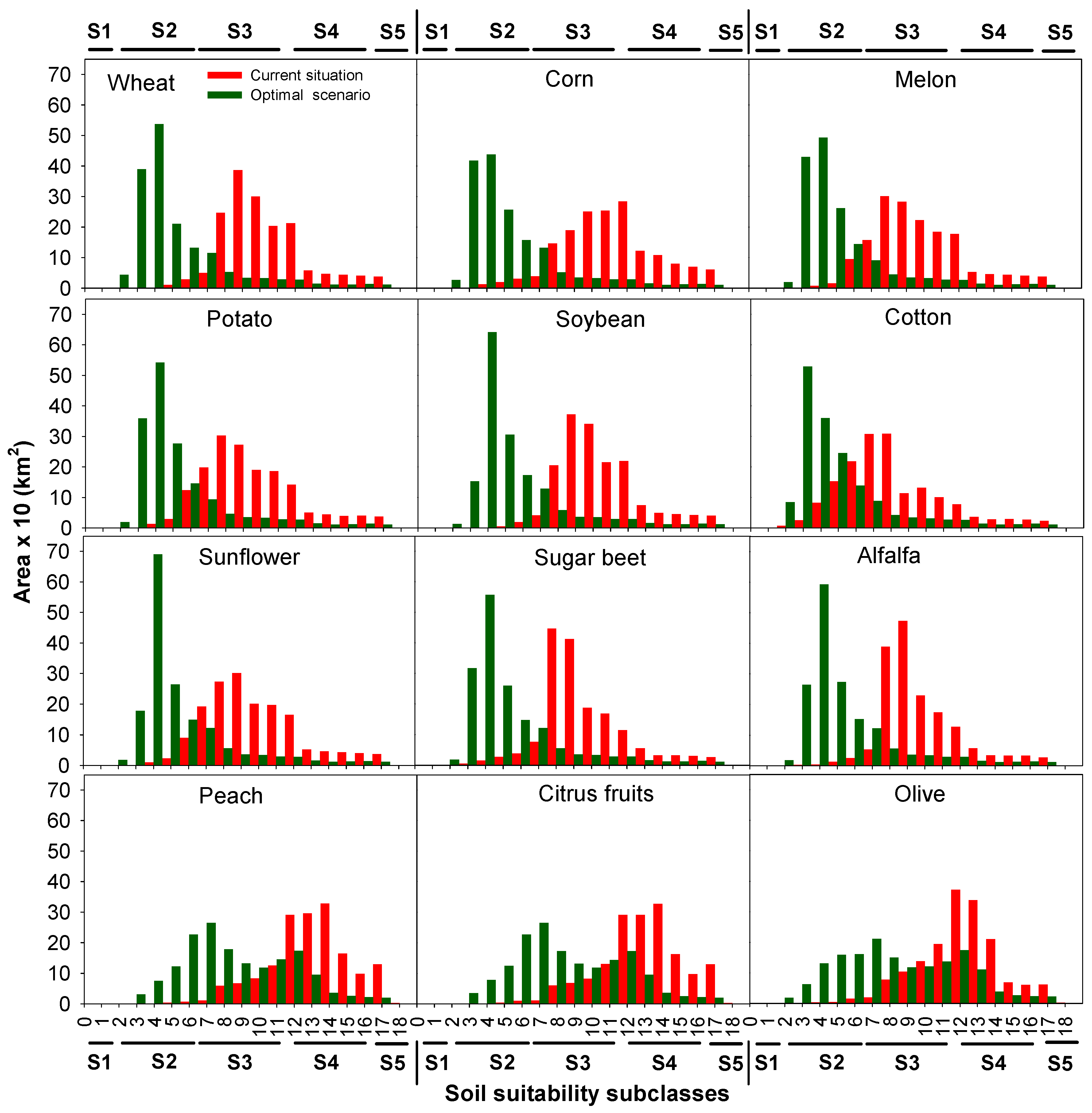

| Unit | Taxonomy (USDA, 2014) | Area | |||
|---|---|---|---|---|---|
| Urban Included | Urban Excluded | ||||
| km2 | % | km2 | % | ||
| PU1-Flood plain | VTFE | 59.47 | 3.33 | 55.5 | 3.32 |
| PU2-Fan | TTFE and VTFE | 374.51 | 20.98 | 336.04 | 20.13 |
| PU3-Basin | THCI and VTFE | 295.16 | 16.54 | 283.43 | 16.98 |
| PU4-Transition A | THCI, THGI, and VTFE | 347.5 | 19.47 | 325.87 | 19.52 |
| PU5-Transition B | VTFE and THCI | 182.81 | 10.24 | 166.81 | 9.99 |
| PU6-Oldest lake terraces | TTPE and THCI | 234.32 | 13.13 | 226.47 | 13.57 |
| PU7-Old lake terraces | TTFE and THCI | 203.03 | 11.38 | 192.85 | 11.55 |
| PU8-Recent lake terraces | THIS | 87.87 | 4.92 | 82.58 | 4.95 |
| Total | 1784.67 | 100 | 1669.54 | 100 | |
| Physiographic Unit | Particle Size Distribution, % | OM, | EC, | pH | CaCO3, | ESP, | CEC, meq/100 g | ||
|---|---|---|---|---|---|---|---|---|---|
| Sand | Silt | Clay | % | dS/m | % | % | |||
| PU1 | 43.97 | 24.17 | 31.86 | 2.05 | 2.56 | 7.55 | 3.69 | 8.72 | 24.96 |
| PU2 | 19.13 | 28.74 | 52.13 | 1.59 | 5.79 | 8.21 | 4.9 | 14.55 | 41.16 |
| PU3 | 57.54 | 19.85 | 22.61 | 1.54 | 5.92 | 7.94 | 13.45 | 12.03 | 19.8 |
| PU4 | 32.25 | 34.92 | 32.83 | 1.28 | 2.86 | 8.07 | 14.81 | 17 | 26.92 |
| PU5 | 43.74 | 21.8 | 34.45 | 1.21 | 10.86 | 8.11 | 19.71 | 10.1 | 26.02 |
| PU6 | 77.66 | 8.73 | 13.61 | 0.72 | 2.43 | 7.72 | 7.18 | 8.87 | 13.34 |
| PU7 | 35.95 | 26.33 | 37.72 | 1.17 | 8.98 | 8.08 | 18.33 | 14.1 | 35.75 |
| PU8 | 42.6 | 16.68 | 40.73 | 2.2 | 31.89 | 8.41 | 11.38 | 19.83 | 30 |
| Soil Salinity (dSm−1) a | Area | Sodium Saturation (%) | Area | ||
|---|---|---|---|---|---|
| km2 | % | km2 | % | ||
| 1.65–2 | 0.79 | 0.05 | 5.36–7 | 1.27 | 0.08 |
| 2–4 | 586.37 | 35.12 | 7–10 | 282.72 | 16.93 |
| 4–6 | 592.08 | 35.46 | 10–12 | 326.89 | 19.58 |
| 6–8 | 213.74 | 12.80 | 12–15 | 658.23 | 39.43 |
| 8–10 | 84.68 | 5.07 | 15–17 | 215.60 | 12.91 |
| 10–16 | 106.46 | 6.38 | 17–20 | 113.84 | 6.82 |
| >16 | 85.42 | 5.12 | 20–22 | 41.88 | 2.51 |
| Total | 1669.54 | 100.00 | 22–25 | 29.09 | 1.74 |
| >25 | 0.01 | 0.00 | |||
| Total | 1669.54 | 100.00 | |||
| Profile Code | Soil Factors/Classification | Crops | |||||||||||
|---|---|---|---|---|---|---|---|---|---|---|---|---|---|
| I | II | III | IV | V | VI | VII | VIII | IX | X | XI | XII | ||
| F10 | Useful depth (p) | 1 | 1 | 1 | 1 | 1 | 1 | 1 | 1 | 1 | 1 | 1 | 1 |
| Texture (t) | 1 | 1 | 2 | 2 | 1 | 2 | 1 | 1 | 1 | 2 | 2 | 3 | |
| Drainage (d) | 3 | 2 | 2 | 2 | 3 | 2 | 2 | 3 | 3 | 4 | 4 | 4 | |
| Carbonate (c) | 2 | 1 | 1 | 1 | 2 | 1 | 2 | 2 | 2 | 1 | 1 | 2 | |
| Salinity (s) | 1 | 1 | 2 | 2 | 2 | 1 | 2 | 1 | 2 | 2 | 2 | 2 | |
| Sodium sat (a) | 2 | 2 | 2 | 2 | 2 | 1 | 2 | 1 | 2 | 2 | 2 | 2 | |
| Profile dev (g) | 1 | 1 | 1 | 1 | 1 | 1 | 1 | 1 | 1 | 2 | 2 | 1 | |
| CS classification | S3d | S2da | S2tdsa | S2tdsa | S3d | S2td | S2dcsa | S3d | S3d | S4d | S4d | S4d | |
| OS classification | S2c | S1 | S2t | S2t | S2c | S1 | S2c | S2c | S2c | S2t | S2t | S2t | |
| F22 | Useful depth (p) | 1 | 1 | 1 | 1 | 1 | 1 | 1 | 1 | 1 | 1 | 1 | 1 |
| Texture (t) | 1 | 1 | 2 | 2 | 1 | 2 | 1 | 1 | 1 | 2 | 2 | 3 | |
| Drainage (d) | 1 | 1 | 1 | 1 | 1 | 1 | 1 | 1 | 1 | 2 | 2 | 2 | |
| Carbonate (c) | 2 | 1 | 1 | 1 | 2 | 1 | 2 | 2 | 2 | 1 | 1 | 2 | |
| Salinity (s) | 4 | 4 | 4 | 4 | 4 | 3 | 4 | 3 | 3 | 5 | 5 | 3 | |
| Sodium sat (a) | 2 | 3 | 2 | 2 | 2 | 1 | 2 | 1 | 2 | 2 | 2 | 2 | |
| Profile dev (g) | 1 | 1 | 1 | 1 | 1 | 1 | 1 | 1 | 1 | 2 | 2 | 1 | |
| CS classification | S4s | S4s | S4s | S4s | S4s | S3s | S4s | S3s | S3s | S5s | S5s | S3ts | |
| OS classification | S2c | S1 | S2t | S2t | S2c | S2c | S2c | S2c | S2c | S2tcg | S2tdg | S3t | |
| F26 | Useful depth (p) | 1 | 1 | 2 | 1 | 2 | 2 | 2 | 2 | 2 | 3 | 3 | 3 |
| Texture (t) | 2 | 2 | 2 | 2 | 2 | 2 | 2 | 2 | 2 | 4 | 4 | 4 | |
| Drainage (d) | 4 | 3 | 3 | 3 | 4 | 3 | 3 | 4 | 4 | 5 | 5 | 5 | |
| Carbonate (c) | 1 | 2 | 2 | 2 | 1 | 2 | 1 | 1 | 1 | 2 | 2 | 1 | |
| Salinity (s) | 5 | 5 | 5 | 5 | 5 | 5 | 5 | 5 | 5 | 5 | 5 | 5 | |
| Sodium sat (a) | 3 | 4 | 3 | 3 | 3 | 3 | 3 | 3 | 3 | 3 | 3 | 3 | |
| Profile dev (g) | 2 | 2 | 2 | 2 | 2 | 2 | 2 | 2 | 2 | 2 | 2 | 2 | |
| CS classification | S5s | S5s | S5s | S5s | S5s | S5s | S5s | S5s | S5s | S5s | S5s | S5s | |
| OS classification | S5s | S5s | S5s | S5s | S5s | S5s | S5s | S5s | S5s | S5s | S5s | S5s | |
| Class/Scenarios | Crops | |||||||||||||||||||||||
|---|---|---|---|---|---|---|---|---|---|---|---|---|---|---|---|---|---|---|---|---|---|---|---|---|
| Wheat | Corn | Melon | Potato | Soybean | Cotton | Sunflower | Sugar Beet | Alfalfa | Peach | Citrus Fruits | Olive | |||||||||||||
| A | B | A | B | A | B | A | B | A | B | A | B | A | B | A | B | A | B | A | B | A | B | A | B | |
| S2-high | 2.48 | 78.7 | 3.77 | 77.8 | 7.14 | 80.8 | 9.92 | 80.4 | 1.43 | 77.1 | 29.1 | 81.3 | 7.38 | 77.8 | 5.17 | 77.8 | 2.58 | 77.8 | 0.68 | 27.3 | 0.84 | 27.9 | 1.39 | 31.9 |
| S3-moderate | 71.1 | 15.8 | 52.8 | 16.8 | 68.9 | 13.8 | 68.9 | 14.1 | 70.4 | 17.2 | 57.6 | 13.4 | 69.7 | 16.6 | 77.3 | 16.5 | 78.8 | 16.6 | 20.7 | 50.4 | 21.1 | 49.9 | 31.9 | 44.3 |
| S4-marginal | 24.1 | 4.8 | 39.8 | 4.81 | 21.7 | 4.72 | 19 | 4.78 | 25.8 | 5.01 | 11.9 | 4.66 | 20.7 | 4.93 | 15.9 | 4.94 | 17 | 4.92 | 70.7 | 21.1 | 70.1 | 21 | 62.8 | 22.5 |
| S5-not suitable | 2.28 | 0.68 | 3.69 | 0.67 | 2.3 | 0.67 | 2.21 | 0.68 | 2.38 | 0.71 | 1.38 | 0.66 | 2.22 | 0.69 | 1.55 | 0.69 | 1.61 | 0.69 | 7.95 | 1.22 | 7.93 | 1.22 | 3.84 | 1.32 |
| Total | 100 | 100 | 100 | 100 | 100 | 100 | 100 | 100 | 100 | 100 | 100 | 100 | 100 | 100 | 100 | 100 | 100 | 100 | 100 | 100 | 100 | 100 | 100 | 100 |
© 2019 by the authors. Licensee MDPI, Basel, Switzerland. This article is an open access article distributed under the terms and conditions of the Creative Commons Attribution (CC BY) license (http://creativecommons.org/licenses/by/4.0/).
Share and Cite
Abd-Elmabod, S.K.; Bakr, N.; Muñoz-Rojas, M.; Pereira, P.; Zhang, Z.; Cerdà, A.; Jordán, A.; Mansour, H.; De la Rosa, D.; Jones, L. Assessment of Soil Suitability for Improvement of Soil Factors and Agricultural Management. Sustainability 2019, 11, 1588. https://doi.org/10.3390/su11061588
Abd-Elmabod SK, Bakr N, Muñoz-Rojas M, Pereira P, Zhang Z, Cerdà A, Jordán A, Mansour H, De la Rosa D, Jones L. Assessment of Soil Suitability for Improvement of Soil Factors and Agricultural Management. Sustainability. 2019; 11(6):1588. https://doi.org/10.3390/su11061588
Chicago/Turabian StyleAbd-Elmabod, Sameh Kotb, Noura Bakr, Miriam Muñoz-Rojas, Paulo Pereira, Zhenhua Zhang, Artemi Cerdà, Antonio Jordán, Hani Mansour, Diego De la Rosa, and Laurence Jones. 2019. "Assessment of Soil Suitability for Improvement of Soil Factors and Agricultural Management" Sustainability 11, no. 6: 1588. https://doi.org/10.3390/su11061588











